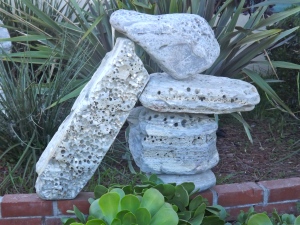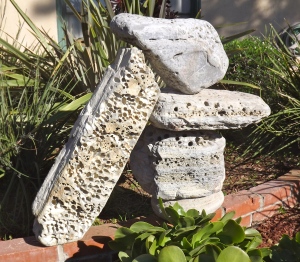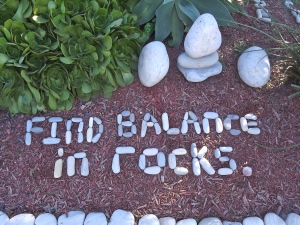 Pierre Jardin took special pride in assembling these stones, bringing them to balance, coalescing them into a configuration. This sculpture is surely the most massive Pierre has made, and the only one hazardous to his health–stabilizing the stones entailed holding the middle one on the right between his knees, while finding the apt angle to lean the one on the left flush with the bricks on the bottom and the edge of the rock on the top. The first attempt ended in the pile falling and Pierre narrowly escaping a broken foot. The second time, Pierre maneuvered the top rock into a leaning-left balance that simultaneously prevents the middle rock from falling to the right. Individually, the stones were
Pierre Jardin took special pride in assembling these stones, bringing them to balance, coalescing them into a configuration. This sculpture is surely the most massive Pierre has made, and the only one hazardous to his health–stabilizing the stones entailed holding the middle one on the right between his knees, while finding the apt angle to lean the one on the left flush with the bricks on the bottom and the edge of the rock on the top. The first attempt ended in the pile falling and Pierre narrowly escaping a broken foot. The second time, Pierre maneuvered the top rock into a leaning-left balance that simultaneously prevents the middle rock from falling to the right. Individually, the stones were  immobile, possessing a ponderous stolidity. Figuring out how to stack them in a stable yet precarious form proved pedagogical. Pierre learned that he had to stop fighting the rocks; not to encounter them as a foe but feel them as a flow. Focusing on the forces coursing through them created a dynamic relationship linking together brain, body, and stone–limbs and rocks moved as a multiplicity, until the stone stack could be safely separated and left solid in its solitude.
immobile, possessing a ponderous stolidity. Figuring out how to stack them in a stable yet precarious form proved pedagogical. Pierre learned that he had to stop fighting the rocks; not to encounter them as a foe but feel them as a flow. Focusing on the forces coursing through them created a dynamic relationship linking together brain, body, and stone–limbs and rocks moved as a multiplicity, until the stone stack could be safely separated and left solid in its solitude.
Reflecting on this process, Pierre concluded that the lesson learned could be formulated as a petriverse: “FIND BALANCE in rocks.” The phrase twins together the physical process of finding how to balance rocks and the psychical process of finding mental balance with the rocks. The phrase’s imperative form–‘find balance in rocks, and that’s an order!’–implies  that the one (physical balance) requires the other (psychic balance). Finally, the words encourage passersby to look around and discover the balance that can be seen in the stone stacks throughout the garden. Finding the balance requires more than seeing the stones standing up; spectators have to follow lines of force, to feel the ways that stones offset and compensate for one another as they come together.
that the one (physical balance) requires the other (psychic balance). Finally, the words encourage passersby to look around and discover the balance that can be seen in the stone stacks throughout the garden. Finding the balance requires more than seeing the stones standing up; spectators have to follow lines of force, to feel the ways that stones offset and compensate for one another as they come together.



